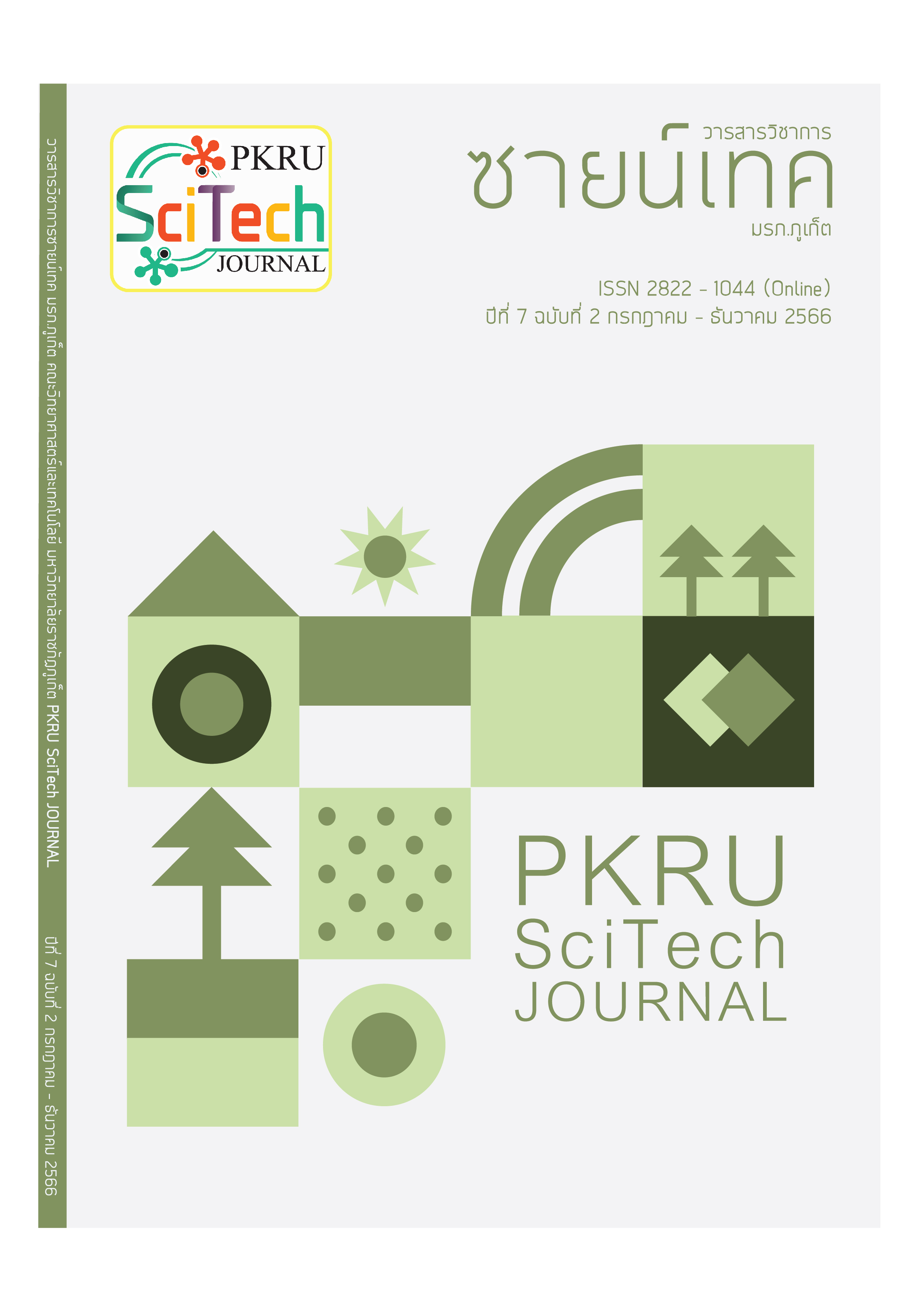The Smart Control System of Cattle Barn and Grass Irrigation for Beef Cattle Farm
Main Article Content
Abstract
The objective of this research is to develop the smart control system of cattle barn and grass irrigation for beef cattle farm and evaluate the system's operational efficiency. The authors have developed an Android application for controlling cattle barn and grass irrigation to operate the kits through smartphones. The design of the control circuit is divided into two parts: The cattle barn control circuit consists of a NodeMCU ESP8266 connected to a temperature and humidity sensor that measures and transmits data to the cloud server to display real-time graphs over a 4G wireless internet network, and controls spraying and a fan for reduce temperature in the cattle barn. Part 2: The Napier grass irrigation control circuit uses the NodeMCU esp8266, the soil moisture sensor X-SM01 connects the relay to activate the pump and solenoid valve. The system was set up for testing in the cattle barns of Community Enterprises of Nayom Subdistrict Beef Cattle Breeders, Phetchabun. It can automatically record temperature and humidity statistics. It was found that when the automatic fogging test was conducted for 3 minutes, the temperature in the cattle barn decreased by an average of 0.39 °C and the humidity increased by an average of 2.47 %RH. The automatic grass irrigation control system can operate correctly in all control modes. Messages about the system status can be sent to the application LINE.
Article Details

This work is licensed under a Creative Commons Attribution-NonCommercial-NoDerivatives 4.0 International License.
- The original content that appears in this journal is the responsibility of the author excluding any typographical errors.
- The copyright of manuscripts that published in PKRU SciTech Journal is owned by PKRU SciTech Journal.
References
ทัศนีย์ อภิชาติสรางกูร. (2545). ผลของความเครียดจากสภาพอากาศร้อนต่อประสิทธิภาพระบบสืบพันธุ์ในสัตว์เคี้ยวเอื้อง.วารสารเกษตร มหาวิทยาลัยเชียงใหม่, 18(2), 148-156.
ประภาส เริงรื่น. (2546). การพัฒนาระบบควบคุมอัตโนมัติในโรงเรือนปศุสัตว์. วิทยานิพนธ์ ปริญญาวิศวกรรมศาสตรมหาบัณฑิต. กรุงเทพฯ: สถาบันเทคโนโลยีพระจอมเกล้าเจ้าคุณทหารลาดกระบัง.
ณัชวิชญ์ ติกุล, และสุวิทย์ ประชุม. (2563). ผลกระทบจากรูปแบบโรงเรือนและสภาพแวดล้อมต่อความสบายของโคในฟาร์มรายย่อยในจังหวัดเชียงใหม่. วารสารเกษตรพระวรุณ มหาวิทยาลัยราชภัฏมหาสารคาม, 16(2), 293-306.
Boonsanita, D., Chanpongsangb, S., & Chaiyabutr, N. (2011). Effects of supplemental recombinant bovine somatotropin andmist-fan cooling on the renal tubular handling of sodium in different stages oflactation in crossbred Holstein cattle. Research in Veterinary Science, 93(1), 417-426.
นภาพร เวชกามา ธีระรัตน์ ชิณแสน, และวันทนีย์ พลวิเศษ. (2560). การผลิตและการจัดการโคเนื้อแบบขังคอกและแบบปล่อยฝูงของเกษตรกร อำเภอบรบือ จังหวัดมหาสารคาม. วารสารแก่นเกษตร, 45(ฉบับพิเศษ1), 1476-1482.
กรมปศุสัตว์. (2545). หญ้าเนเปียร์. กองอาหารสัตว์. [ออนไลน์], สืบค้นจาก http://nutrition.dld.go.th/Nutrition_Knowlage/information1/39.pdf (10 กรกฎาคม 2563).
LINE Corporation. (2562). Messaging API. [ออนไลน์], สืบค้นจาก https://developers.line.biz/en/services/messaging-api/ (10 มีนาคม 2563).
Tresoldi, G., Schutz, K. E., & Tucker, C. B. (2018). Cooling cows with sprinklers: Spray duration affects physiological responses to Heat Load. Journal of Dairy Science, 101(5), 4412-4423.
วิษณุ ช้างเนียม, และวริษา สินทวีวรกุล. (2562). เพิ่มประสิทธิภาพการบริหารจัดการฟาร์มไก่ไข่ด้วยการใช้แอปพลิเคชันระบบปฏิบัติการแอนดรอยด์และควบคุมสภาพแวดล้อมภายในโรงเรือนด้วยระบบฟัซซีลอจิก. วารสารวิศวกรรมฟาร์มและเทคโนโลยีการควบคุมอัตโนมัติ, 5(2), 77-88.
Fournel, S., Ouellet, V., & Charbonneau, É. (2017). Practices for Alleviating Heat Stress of Dairy Cows in Humid Continental Climates: A Literature Review. Animals: an open access journal from MDPI, 7(5), 37.
Sadiku, M. N. O., Ashaolu, T. J., Ajayi-Majebi, A., & Musa, S. M. (2020). Smart Farming. International Journal of Scientific Advances, 1(3), 133-134.


